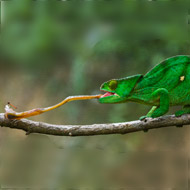
Findings may benefit the field of biomimetrics
A team of scientists from the University of Oxford have devised a mathematical model to explain how a chameleon is able is unravel its tongue so fast.
Researchers from the Mathematical Institute, together with a team from Tufts University in the USA, formed a system of differential equations to capture the mechanics of energy build-up and ‘extreme acceleration’ of the reptile’s tongue.
It is hoped that their study, published in Proceedings of the Royal Society A, will be useful in the field of biomimetics - the imitation of nature for the purpose of solving complex human problems.
Explaining the work, lead author Derek Moulton said: “If you are looking at the equations they might look complex, but at the heart of all this is Newton’s Second Law - the sort of thing that kids are learning in A-levels, which is simply that you’re balancing forces with accelerations.
“In mathematical terms, what we’ve done is used the theory of non-linear elasticity to describe the energy in the various tongue layers and then passed that potential energy to a model of kinetic energy for the tongue dynamics.”
It is said that if a chameleon’s tongue was a car it could accelerate from 0 to 60 mph in 1/100th of a second.
The team believe that special collagenous tissue found within the chameleon’s tongue is the secret to its effectiveness. The tissue surrounds a bone at the core of the tongue and is surrounded itself by a muscle.
“The muscle - the outermost layer- contracts to set the whole thing animation,” commented Professor Moulton. “We’ve modelled the mechanics of the whole process; the build-up and release of energy.”



 The Animal and Plant Health Agency (APHA) has updated its online reporting service for dead wild birds.
The Animal and Plant Health Agency (APHA) has updated its online reporting service for dead wild birds.